Text
EV Road Trip, December 25-29, 2023
I’ve had my BMW i4 eDrive40 for a little under five months now and I finally got the chance to take it out for an extended road trip to visit family in Louisiana this past Christmas. Fear of the unknown is baked in with any new tech and electric vehicles are no exception. In this case, most of my anxiety was related to the availability of fast chargers on the road and questions over how close the car would get to its estimated range of 301 miles on a full charge. Knoxville to Baton Rouge clocks in around 650 miles one way, meaning I would need to fast charge on the road multiple times. I wanted to share my experience here for current EV owners and anyone who may be considering acquiring an EV to give you a sense of the current state of things in this neck of the woods.

Most of my charging is done at home, I’d say around 90%. This number hovers around 80% for EV owners in general. I have a Level 2 charger in my garage that I use to recharge the battery when I’m at home. The charger itself came with my car, and I hired an electrician to install a 240V outlet (basically, a dryer outlet) to enable me to complete a full charge within a reasonable amount of time. My car is capable of charging from a regular 110V outlet in a speedy 80 hours. Using the 240, it will fully charge in 8-10 hours, meaning you can wake up with a full battery every morning if you so choose. Realistically, I only need to charge about once a week, maybe twice if it’s a busy week. My cost to fuel up at home is around $6.15 for 300 miles of driving. Compare that to my last internal combustion engine (ICE) car, a Ford Fusion that got around 30 mpg, which would cost me $27 to do the same distance at today’s price of $2.70 per gallon, or closer to $45 at the peak of a few years ago. This is truly an ideal situation, right in the sweet spot for EV driving these days, and one of the main reasons I bought this car, along with the obvious environmental benefits and the sheer pleasure of driving these vehicles. I haven’t visited a gas station since August. I nearly pulled into one to grab a soda a few weeks ago but thought to myself, “No, I don’t belong here,” and popped over to the grocery store instead.

Although EVs have been in mass production for over a decade, the state of public charging is highly variable depending on where you live and what kind of car you have. The first thing to know is that there are two main types of EV plugs: Tesla’s and everyone else’s. If you drive a Tesla, you have access to their Supercharger network, which is by far the most extensive and reliable network in North America. If you have anything else, you are relegated to using a mishmash of public charging networks that each have their own apps and payment systems and varying degrees of reliability. Electrify America, ChargePoint, EV Connect, and EVgo are some of the more popular ones. Last year, most of the major car companies committed to adopting Tesla’s NACS standard in the U.S., unlocking access the Supercharger network using an adapter sometime in 2024 and without one in the coming years, but at the time of my trip I could only access a small handful of Tesla chargers, none of which were really along my route.
I’ve taken a couple of shorter road trips to locations within a few hours of my home in the past few months and had a largely positive experience. My stated range of 301 miles can fluctuate depending on various factors including the outside temperature, the speed I’m driving, the amount of cargo I’m hauling including luggage and passengers, and things like how much heat or AC I’m using. It can also be reduced by degradation of the battery, but my car is still too new for that really to be an issue.
At Thanksgiving we drove to my in-laws’ house near Athens, GA, 240 miles away, through both highways and winding, hilly backroads. I arrived with 20% battery life, meaning my car hit its benchmark exactly. I brought my charger along and hooked up to their 240V outlet (my father-in-law had it installed in anticipation of getting his own EV at some point—he has a Cybertruck on order) and got the battery back up to 100% overnight. No public charging was required for that trip, making it even easier than doing the same trip in my old Fusion since I didn’t have to stop to refuel on the road.
We made short trips to Nashville and Atlanta in December, both of which required me to use public charging, with mixed results. In Nashville I used an Electrify America station near the airport, about 25 minutes from our Airbnb. I ended up having to make two separate trips to that station because their payment network was offline during the first visit and they had the charger set to complementary mode, which would have been nice save for the fact that I already get two years of free charging with Electrify America through BMW, and because it was free they lowered the charging speed (“derated” it, in EV parlance) to 40 kW. My car is capable of a max of 205 kW, so a steady 40 kW increases the charging time significantly. I should be able to get from 20% to 80% battery within 30 minutes but I sat at that charger for 41 minutes and only recovered 32% of my battery (30% to 62%) before I ran out of time and had to leave. I went back the next morning to top it off and after trying a couple of different stalls I was able to get up to 93 kW, still well below my car’s potential. Regardless, I was able to charge and get back home without having to pay anything because of my free subscription through BMW.
When we went to Atlanta, I charged in a suburban shopping area in Kennesaw, northwest of the metro area, and topped out at 147 kW, going from 20% to 75% in 25 minutes, also free of charge through Electrify America. Around 10 other vehicles were docked at the same station, including some that I had never seen in the wild before, like a BMW iX, a Genesis GV60, and a Volkswagen eGolf. I have become an expert (or as my wife Young pronounces it, “dork”) at recognizing EVs on the road, and it’s always a treat to see one I’ve never seen before. I charged at another Electrify America station in Atlanta on that trip, this one in a Walmart parking lot. Speeds were not quite as good, but I was able to get the charge I needed while passing the time inside the store grabbing a few last-minute gifts while I waited for my charge to complete. We also stopped at an EVgo station at a Flying J Travel Center just outside of Knoxville to top off. Pilot and Flying J are partnering with GM to install chargers at hundreds of their gas stations in the next few years, a huge boon to EV drivers. This station was one of the nicest I’ve seen, with covered parking by the chargers, a full convenience store with restrooms and even a restaurant. It was also very expensive compared to other fast charging stations: this stop cost me $16.88 to pull down 26 kWh ($0.65/kWh). My cost at home would have been around $2. Still, I would love to see this kind of setup become the norm.
Because of various family and professional scheduling conflicts, Young and I found ourselves driving from Knoxville to Baton Rouge on Christmas Day. There are plusses and minuses to driving on Christmas. On the plus side there is very little traffic on the road and consequently very little congestion at fast charging stations. I’ve made this trip dozens of times and it typically takes around 10 to 10.5 hours in an ICE vehicle, already a long day. One of the things I worried about with the EV is arriving at a charging station fully occupied by other drivers and having to wait 30 minutes or an hour to charge my car. Travelling on Christmas when very few people are on the road means it’s that much less likely you’ll get stuck behind other drivers, and indeed I never had to wait for a charger (the trip back home was a slightly different story as you’ll see later).
The downside is that nothing is open. Many charging stations are situated at the edges of Walmart or Target parking lots, meaning they can be accessed at any time of day or night, but along my route, the only option was often at a car dealership that could very well be behind a locked gate during off hours. Since this would be my first time charging at these particular stations, I felt I needed to do a little extra research to make sure I would have no trouble accessing the chargers I needed.
I spent an inordinate amount of time using various EV route planning apps to identify the most efficient way to reach my destination. BMW has their own navigation system, which sensibly focuses heavily on the location of charging stations, and there are other third-party apps like A Better Route Planner (ABRP) and ChargeHub that do more or less the same thing, though each has its own nuances. The basic way they work is that you input your origin and destination, what type of car you have and your current battery percentage, and it plots your route and tells you where you will need to stop and for how long to achieve the maximally efficient road trip. This is good in theory, but the charger inventory on each app is slightly different, and they have different opinions of which stops are the best options for your trip. I ended up considering several different possibilities and picked the stops that seemed to make the most sense. I slightly favored Electrify America stations since they are currently free to me, and I tried to stay away from slower chargers when possible. I also tried to find backups in case my preferred stations were for some reason unavailable.
Mississippi was the toughest leg of the trip to navigate, since there are really very few good options throughout much of the state. My apps kept trying to route me to a charger at a dealership in Hattiesburg that has a maximum speed of 50 kW. Even if that were the most efficient overall route, I just couldn’t see myself sitting at that station for over an hour to wait for my car to recharge, so I routed around it, opting to stop at a dealership in Jackson with a faster charger. Even though some of the apps say this charger is 180 kW, it’s actually only 90, but it’s still the fastest charger for hundreds of miles around. Since this would be a crucial stop on my trip, I called several days in advance to make sure that I could actually access the property and the charger on Christmas Day. The salesman assured me that the gate would be open, but trusting a stranger multiple states away with information that, if wrong, could leave me stranded on the one day of the year tow trucks will be most difficult to get, is inevitably going to be a little scary. Regardless, I decided to operate under the assumption that I was receiving accurate information and that the charger would be open when I needed it.
With all my planning done and feeling pretty good about the stops I had selected, I loaded the car with suitcases, sandwiches and snacks for the road, Christmas gifts, a guitar or two, a very sleepy spouse, and a very nervous cat, and we hit the road around 6:45am. As anticipated, the roads were as empty as I’ve ever seen them, even in normally congested areas like Chattanooga. Our first stop was Fort Payne, AL, 170 miles from home, at a ChargePoint station in a parking lot near a rail depot. This station is rated at 125 kW, and I was able to achieve a charging speed of 86 kW, going from 31% to 75% in 29 minutes. I was grateful to have downloaded the ChargePoint app ahead of time, because that seemed to be the only way to pay at this station. In fact, I had downloaded every app I could think of a few days prior, created accounts, and linked my payment method. If I hadn’t done this, I would have spent significantly longer fumbling with apps in the cold and drizzling rain just to get a charge. Cost was fairly reasonable, $15.60 for 37 kWh ($0.42/kWh). Overall, this was a nice stop, right in the middle of downtown, with shops and cafes within easy walking distance, and relatively clean public restrooms that were accessible even on Christmas Day. I look forward to stopping here again when things are actually open.

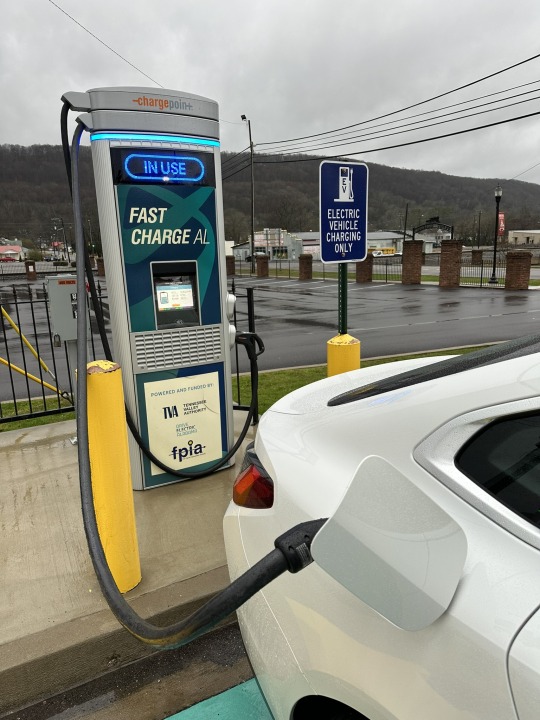

Next up was an Electrify America station 132 miles from Fort Payne at the Mercedes Benz Welcome Center in Vance, AL. Mercedes, like a lot of foreign car manufacturers, has factories in the non-unionized south, and this is their flagship location. The chargers—six of them, all empty—are set up in the visitor’s center parking lot. Payment authorization was again done using an app. The first cable I tried didn’t recognize my car so I had to try a second, which connected right away. There was a beautiful Mercedes EQE SUV across the parking lot, probably a demo for the EV curious. On normal days there would be restrooms available, but no such luck today. Still, this was one of the fastest chargers I’ve used to date, topping out at 169 kW. I arrived with 21% and left 30 minutes later with 80%, pretty much exactly as the brochure advertised. I should have stayed another 10 minutes.
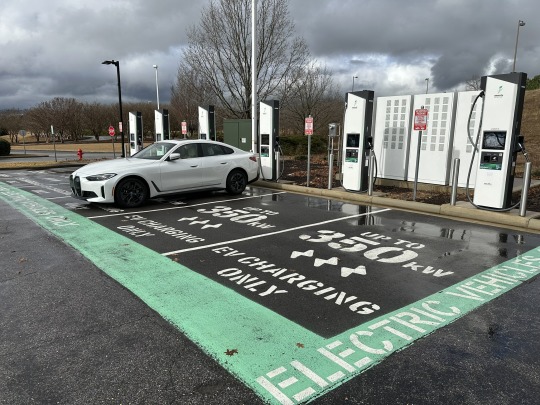
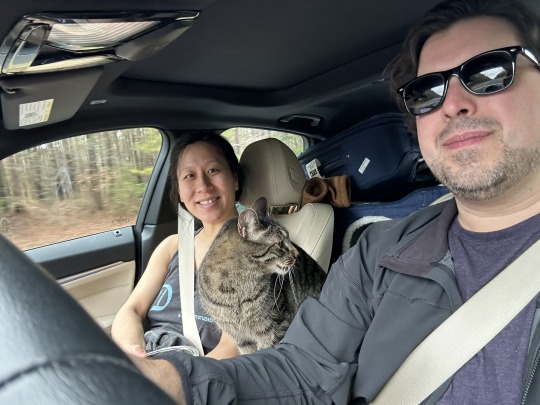
The third and final charging stop on this trip was the aforementioned EV Connect station at the dealership in Jackson, 200 miles from stop #2. If you do the math here, my car was at 80% battery leaving Mercedes, supposedly 240 miles of range if you believe the estimates. I figured I would arrive in Jackson with around 10-12% of battery left. What I was not accounting for was 1) the weather, as EV batteries lose range in the cold, plus we were running the heater at a pretty good clip, 2) my highway speeds, close to 80 mph on wide open Interstate, and 3) a fully laden vehicle with much more cargo than I typically carry.
My car’s nav system can be set to arrive at a destination with a specified battery percentage. I had it configured to arrive with at least 10% remaining. For the first part of this leg of the trip, that seemed achievable, with an estimated arrival percentage of about 13%. But slowly I watched that drop to 12%, then 11%, then 10%. When it dipped below 10%, my car began to warn me that we wouldn’t make it, and suggested I make another stop to charge.
That was not what I wanted to hear, so I updated the arrival status to 5% battery. The percentage continued to drop: 9%, 8%, 7%. At this point, I decided that I didn’t particularly want to wait hours for a tow truck on Christmas Day, so it was either make another stop or take measures to reduce battery consumption. I opted for door #2, turning down the heat and reducing my speed to 70 mph. There wasn’t any cargo I could unload, so that’s about all I could do. Thankfully, it was enough. The estimated arrival percentage stopped dropping and I was able to make it to Jackson with 6% battery remaining.
This was not an experience I would recommend to anyone. It seemed like every exit I passed from Vance to Jackson had at least one gas station. Many had 3 or 4. But charging stops in this part of the country can be 100 miles apart or more, so if you miss your chance to charge when you can, or if your app was wrong about there being a station there, or if it’s not open or all the cables are broken or someone parked their ICE truck in front of the charger and left it there all day, your outlook starts to look pretty bleak. On the return trip I encountered a couple from Huntsville in an Audi e-Tron who experienced just that: app routed them to a non-existent charger. Battery was depleted. Tow trucks were called. Garments were rent.
Thankfully we avoided that fate. The dealership’s gates were open, as promised, though I had to cross the steepest speed bumps I’ve ever seen and navigate past the line of Level 2 chargers to find the fast chargers I was looking for. These were of the EV Connect variety, max charging speed of 90 kW. A Mach-E was leaving as I arrived, and a very friendly Tesla driver grabbing some free electrons from the Level 2s chatted me up while we waited. We were at this stop for 50 full minutes charging from 6% to 82%, more than I really needed to get to Baton Rouge, but I wasn’t taking any chances this time. This was also one of the cheapest stops I actually paid for, $21.08 for 65 kWh.
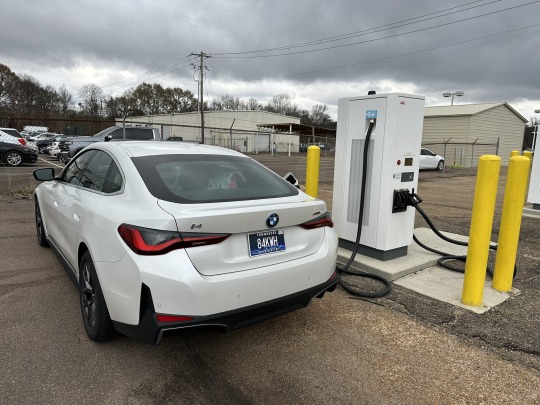

The last leg was uneventful, mostly empty highways and grey skies. Overall, my trip time was around 11.5 hours, 1 to 1.5 hours longer it typically takes me, or 10-15% extra time. Not that bad, all said and done. We didn’t make any additional stops for food, but ate packed sandwiches and snacks in the car, another one of the little joys of travelling on Christmas Day.
In an ideal world, on a long road trip you would be able to pull your car into a charging station near a restaurant, set it to refuel while you enjoy your meal, then come back out just as it hits your desired state of charge. The reality is not always so neat. Stations are often placed in locations that lack the amenities you would hope for (only 1 of the 3 stops on this trip had bathrooms that were open). The dearth of stations also interferes with optimal trip planning. With a 300-mile range, I should theoretically be able to make this trip with only 2 stops rather than 3, but because of where the available chargers are located I had to make some compromises. Charging speed is also an issue. Having access to faster chargers could shave off 25%-50% of the time I spent at charging stations. Tesla has it figured out. Their chargers are fast, reliable, plentiful. Getting access to their network and to the charging infrastructure that’s supposedly on the docket from other companies in 2024 should make this trip much easier on the next go-round.
Baton Rouge, somewhat surprisingly to me, has very few EV charging options. There are a few in the works including an EVgo at a Pilot Travel Center in Denham Springs, noted as “Coming Soon” in the PlugShare app. Thankfully, my parents happen to have a 240V outlet at their house so I was able to do Level 2 charging there with my portable charger while I hung out with them. I also did some fast charging at the Porche dealership in Baton Rouge. That one was weird, a $20 flat fee that you pay inside, meaning you can only charge during business hours. Charging was also slower than I would have expected, 40 minutes to get from 46% to 92% ($0.49/kWh). At least I got to ogle the Taycans they had on the lot while I waited. There was a brand new Kia EV9 charging next to me. The owner was from Houston, in town visiting family. He said he was the first person to take delivery of that vehicle in his city. It looked fantastic, big and black and shiny. His first EV road trip as well.
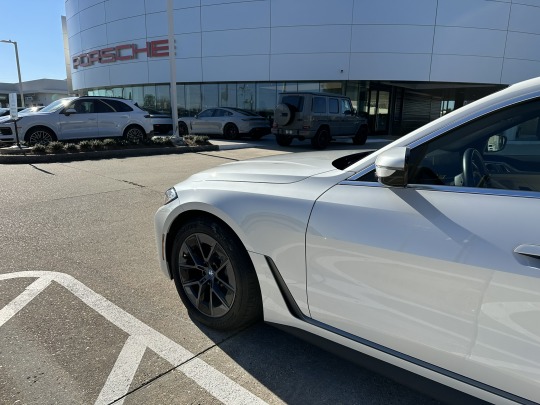

I was able to bop around town on those charges with no problem, never in danger of dropping too low.
The trip back home was significantly more tedious than the trip down. We drove back on December 29, so at least things were open, but unlike our Christmas sojourn we started out around 50% charge instead of 100%, which immediately put us at a disadvantage. It’s generally not recommended to fast charge beyond around 80%, both for the longevity of the battery and because the charging curve drops off sharply beyond that point. It’s almost always faster to get to 80% and do your additional charging at the next station when your battery is further depleted. What this means is that you can’t just multiply your battery capacity by the number of stops you make and expect to make a trip of that distance with anything approaching expediency. Just because my car can go 300 miles on a charge doesn’t mean I can efficiently do a 600-mile road trip with only one recharge. Starting out at 100% is your best shot at satisfactory performance on long trips. Since we didn’t do that, the return trip took 5 stops rather than the 3 we made on the way down.
The first stop was one of my worst charging experiences ever, rivaling the broken and de-rated chargers in Nashville. There were no Electrify America stations in Baton Rouge but we found one just up the road in Hammond, in what appeared to be a rather bougie shopping center with a Target (pronounced the French way, naturally) and a few restaurants. There were four stations, one occupied by a Hyundai Ioniq 5 and two by slow-charging Chevy Bolts. I slid into the fourth slot, which appeared to be online and functioning but which would not connect to my car. I called the Electrify assistance number on the stall and the person on the other end of the line informed me that that particular charger was offline. I told them there was nothing to indicate this. They had no response. Shortly after this, one of the Bolts pulled away so I switched to that stall and connected to start my charge. Unfortunately, the tap-to-pay function wasn’t working on this station, so I had once again to call EA to ask them to kindly allow me to charge my car. We were eventually able to get this to work, but this charger was derated, maxing out at a paltry 46 kW, and it took me 27 minutes to get from 46% to 70%. That was enough to take me to my next stop, so I moved aside to allow the previously mentioned Audi drivers to power up. This was the only station of the trip I failed to get a picture of because I was so frustrated by the experience.

Next it was back to the dealership in Jackson. It was open that day, so I was able to use the restrooms. A Rivian R1T was charging up in the stall beside me, its driver catching a few winks. Still a relatively slow charge, maxing out at 87 kW, taking me from 14% to 93% in 53 minutes, but consistent, and really the only reliable electric port in the Mississippi sea of petrol. This stop cost $20.94 for 64 kWh ($0.32/kWh).
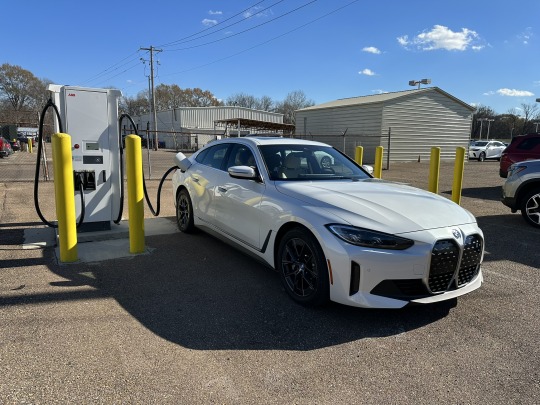
We continued to reverse the trip, travelling the 200 miles back to Mercedes, but this time with extra juice in the tank to avoid the scary scenario we experienced on the way down. Arrived with 15% battery and got up to 80% in 30 minutes, topping out at 156 kW. Again had to try two cables before finding one that would connect. There was another i4 fueling up when we pulled in, sparkling in jet black, one of just a handful I’ve seen on the road.

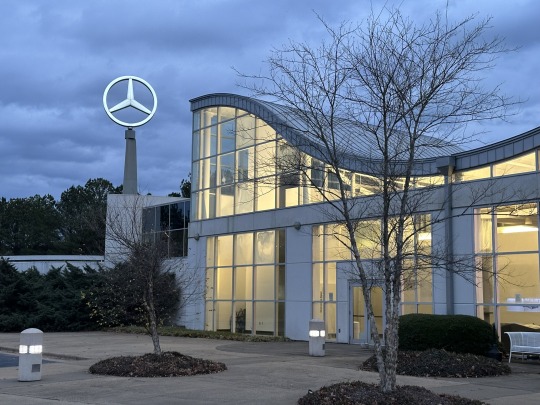

Next, we faced a choice. We could have stopped again in Fort Payne and gotten home on one last charge, but we opted instead to stop in Birmingham, where there looked to be better food options that would still be open when we arrived. The stop itself was a ChargePoint station at a Hyundai dealership northeast of downtown. We grabbed takeout from a taco truck and ate it in the car while we waited. Distance to home was 253 miles, so I figured we could potentially make it without another stop if we topped off the battery. I took it from 59% to 99% in 41 minutes—not a very fast charger (maxed out at 62 kW), plus I was getting into the inefficient part of the charging curve. Cost was $15.94 for 33 kWh ($0.48/kWh).

We were making good time, but the weather and the load were working against us (somehow we came home with nearly as many gifts as we brought with us), so my range wasn’t anywhere close to the published 301 miles. I might have been able to make it all the way home if we had reduced our speed and turned off the heat, but that would have extended our already extremely long trip even further, so I opted to stop instead at an Electrify America in Ooltewah, TN for a quick top up (36% to 50% in 5 minutes, lightning fast) to make sure we’d arrive home with a comfortable buffer, which we did.

With the extra stops, the return trip ended up being over 13 hours, long enough that we were both pretty tired and cranky but ready for a good night’s sleep and grateful that we still had a three-day weekend ahead of us. I was also glad to be back home to my cozy garage where I could plug in my charger and wake up to a fully charged battery for the cost of a fancy coffee.
My total cost for public charging on this trip was $93.88 over a distance of 1,669 miles (would have been somewhat more if not for free Electrify America charging). Add another $15 or so for home charging. For comparison, that distance would have cost $153 in my Fusion at $2.75/gallon.
If you’ve made it this far, thank you for reading, apologies for my long windedness, and I hope it was helpful. Even with all the challenges, I still believe in this technology and I feel strongly that we’re right on the cusp of a tipping point. The signs are looking favorable that 2024 is the year America will get its act together with fast charging. This year, my trip was doable, if a little rough around the edges. This time next year, I hope to be able to report that it’s not only doable, but easy.
1 note
·
View note
Audio
Check out my latest album using the player above or directly through Bandcamp: Upward, Not Northward by Shelby Rushing
Hope you enjoy!
0 notes
Video
youtube
Earlier this year I had the privilege of collaborating on a piece with Dragonfly Circus & Aerial Arts Studio for their annual Circus Extravaganza. One of the themes of this year’s circus was finding yourself in a strange place and learning to develop new modes of existing; to make a home of alien worlds without losing that which is essential to your own being. I wrote this song with those thoughts in mind, and with healthy dollops of inspiration and guidance from Lissa McLeod and Katlyn Gagnier, the incredible aerialists performing on the double lyra in this video. The voice you hear is Mene Manresa Bodipo, who talks about his experience as an immigrant in America and the hopes and fears that accompanied his journey. It’s unscripted poetry delivered straight from the heart. Megan Kehren lent her prodigious viola skills to the track (and graciously showed me how to notate slurs for strings), and Matthew Keys laid down layer upon layer of mighty guitars. I’m honored to have had the opportunity to work with such talented artists and compassionate souls. Call it a minor antidote to the news of the world.
1 note
·
View note
Link
The first official music video from the new album, for the opening track, “Real Life”. For all those who feel like they’re traveling without ever getting there. Hope you enjoy.
0 notes
Link
My latest video, a collaboration with the amazing Shelby Gallagher. Recorded at her house in Baton Rouge last week.
0 notes
Text
Advocate Article
I did an interview with the Baton Rouge Advocate last week about the new album. Give it a read!
“Upward: BR native Shelby Rushing talks new album”
0 notes
Text
Upward Links
The new album, “Upward, Not Northward” is now available on all major digital and streaming platforms:
iTunes
Spotify
Rhapsody/Napster
Amazon
Tidal
CD Baby
Bandcamp
0 notes
Text
Louisiana Underwater
Really tough time for Louisiana right now. Massive flooding throughout the state. More than 30,000 people had to be rescued from life-threatening floodwaters and tens of thousands have lost their homes. People are sleeping in shelters because everyone they know is also flooded. The majority of my family and friends have been affected, many lost everything. My heart aches for them. Heading down to help soon.
0 notes
Text
Upward, Not Northward
Can I tell you a story? Eleven years ago, way back in 2005, I recorded an album called “workmusicsleep”. It was the second album I had put out under my own name, and the title was a summation of my life at the time. I was living in a crappy little apartment off of Gardere Lane, working two jobs, and spending my evenings writing music, putting together bands, and recording in the back room of Book Warehouse. Then I’d go home and sleep for a few hours and do it all again the next day. I was playing in two bands at the time, The Gold Standard and Secret Annexe, but this new music didn’t really fit in with either of those groups, so I put together the Orphan Choir. We played tunes from “workmusicsleep” along with a few from my first solo record, “One Room Life”, which came out in 2002 while I was still in college. We did a few shows around Baton Rouge that summer and fall, but then Hurricane Katrina barreled through and life kind of turned upside down.
Within a year I would start a new job with the little emergency management firm where I still work today, the Gold Standard would disband, and I would start thinking about my next solo project. I was still writing music with Secret Annexe, but every now and then I would come up with something that I would set aside for a solo record. Pretty early on I decided on a title: “Upward, Not Northward”, which comes from the great little book “Flatland” by Edwin A. Abbott. It sounded just mysterious enough but still had a profound meaning for me.
In 2009, I bought my house in Broadmoor and before long I started building demos in Ableton with programmed drums and layered instruments. By 2010, with most of the demos completed, I figured I would have the album wrapped up within a year. I reached out to the late great Paul Kauk, who had done an incredible job mixing the Secret Annexe EP “The Nights Are Growing Long” for his advice, and he encouraged me to get a drummer who could play to a click track and build off of what I had already created. I had recently seen Prom Date put on a great show at the Spanish Moon and remembered their drummer wearing some giant headphones, so I took a shot. I’m so glad I did because Zachary Farris-Bourque turned out to be the perfect guy for the gig. After playing through the songs together only a few times, we blasted through the recordings in a weekend in summer 2011.
After that, it was on to the guitars, bass, keyboards, and vocals. I called on some of my most talented musical compatriots to lay down some tracks. Kyle Bailey shredded the dual leads on “Every House Burns Down”. Shelby Gallagher added some amazing vocals on “Every House” and “Cadences”. My brother Ryan Rushing played percussion on a handful of tracks and drum kit on a new song I wrote called “Half the Sky”, the idea for which came from Nicholas Kristof and Sheryl WuDunn’s eye-opening book of the same name, about the challenges faced by women in the developing world.
Progress on the album was slow. What was supposed to take a few weeks turned into years. Secret Annexe recorded “Deviations” at my house. Work sent me all over the country. I went back to school to work on a Master’s degree. I had met my wife Young at the end of 2010 and we were married within a year and a half. She was working on her doctorate in piano performance at LSU, so I convinced her to take a break from Brahms and Barber to play the keyboard parts I charted out for “Every House” and “Cesium in Blue”. By the summer of 2013, I felt like I was closing in on the record when I got sent up to Albany, New York, for a month. Well, one month turned into three, then six, and before long I had lived through a New England winter and been away for a year and a half. All the while, my guitar gently wept.
In 2014, I moved to Knoxville after Young got a job teaching music at Lincoln Memorial University. Aside from my stint in an Upstate New York hotel room, I had never lived away from Louisiana. Being separated from my network of family, friends, and fellow musicians back home has had its challenges, not the least of which was the lack of psychic energy required to push the album over the finish line. By summer 2015, I finally decided it was well past time to get it done. I blasted through the remaining parts I needed to do, and through Dropbox and email, conscripted a few more brilliant folks to make the songs shine. My old roommate Daniel Lee did some genius guitar work on “Enough”. My brother introduced me to Peter Turner, a fantastic pianist who did some great work on “Enough” and “Carry Me to Carencro”. Dorothy LeBlanc got me in touch with the legendary Lloyd Maines, who did the pedal steel work on “I Want Too Much”.
With all the parts done, I made rough mixes and played them for anyone who would listen. My longtime partner in crime and closest confidant, musical and otherwise, Rob Mulhearn gave me some great suggestions for final tweaks. Not trusting my limited mixing skills, I enlisted the expert ears and brilliant mind of Adam Hains to do the final mix. After working with the songs for a little while he said, “Hey, would you like me to replace your organ parts with a real Hammond organ?” How could I refuse that? You can hear his handiwork on “Every House Burns Down”, “Carry me to Carencro”, and “Enough”.
While we were passing mixes back and forth this spring, I finally dragged myself out of the house to see what Knoxville had to offer in the way of music, and I’ve been humbled by the talent I found here. I played songs from the new album at open mics at Preservation Pub and the Open Chord and had the privilege of seeing lots of talented songwriters and performers. It was just what I needed to hear, and I started writing and demoing the next three records. Inspiration ain’t no joke.
By this summer, we had the mixes wrapped up. The only thing left was album artwork, so I got Grace Emden, one of the best artists I know, on the case. I typed out all the ideas I had, which were probably longer than this note you’re reading now, but Grace was able to make sense of the ramblings and I’m incredibly pleased with the result.
So. Eleven short years after the last Shelby Rushing album, “Upward, Not Northward” is here. It’s hard to find the right word to describe how it feels to be able to present this record to you. Pride is part of it. Also relief. Maybe catharsis is the most accurate. I’ve lived with these songs for so long, but they’ve mostly been in and between my ears, for my own consumption and digestion. Today that changes. Now these songs belong to everyone. I hope you enjoy listening to them as much as I enjoyed writing and piecing them together, track by track, year by year.
“Upward, not Northward” – was the clue to the whole proof. It had seemed to me fairly clear before I fell asleep; and when I first awoke, fresh from my dream, it had appeared as patent as Arithmetic; but somehow it did not seem to me quite so obvious now.
— Edwin A. Abbott from Flatland: A Romance of Many Dimensions
Some final thank yous: Many thanks to everyone who helped to make this collection of tunes a reality. To Zach and Ryan for killing it on the drums. To Nathan for teaching me Ableton. To Rob and Ryan for the critical ear. To Paul Kauk for his insight and generosity. To Daniel and Young for putting up with me playing these parts over and over and over. To John Tillman for lending me the Neumann. To Paul Emden, Jon Kolich, Michael Cole, Zach, Nathan, Ryan, and Steve for helping me to workshop these tunes. To everyone in Secret Annexe—Carbo, Kyle, Kelly, Shelby G., Rob, Phil, Toups, Tammy—for helping me keep my chops up all these years. To Dorothy for getting me hooked up with Lloyd. To the Three Sages for all their sage advice. To the Compact Disc Store (RIP!) for keeping me in endless inspiration and “research”. And, especially, to everyone who’s shared love and encouragement over the years: I couldn’t have done it without you.
Shelby
https://shelbyrushing.bandcamp.com/album/upward-not-northward
0 notes
Photo

New album cover!
artwork by Grace Emden (http://artgracefully.com/)
0 notes
Text
Making Sense
Another song from the new album:
https://soundcloud.com/shelbyrushing/making-sense
0 notes
Link
At long last, a song from the new album! Full album out this week. Enjoy.
0 notes
Photo

Here’s a map I created for a DIY gift swap with friends last Christmas. I symbolized all the shows my old band Secret Annexe played from 2000 to 2013. The background is the album art for “Seven Headed Monster”, a record we released in 2007.
0 notes
Photo

Took some new rock photos today.
1 note
·
View note
Text
SoundCloud!
Just got my SoundCloud page set up and posted a few songs from the archives. I’ll have new music up very soon!
https://soundcloud.com/shelbyrushing
0 notes
